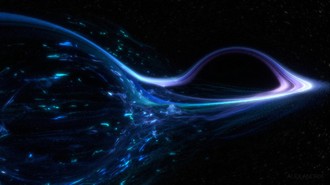
Another unprecedented discovery has just been unveiled by LIGO-Virgo scientists (there are astronomers from CAMK PAN among them:Michał Bejger, Paweł Ciecieląg, Marek Cieślar, Filip Morawski, Magdalena Sieniawska and Ankan Sur). Data from the third observation period (O3) of the Advanced LIGO and Advanced Virgo detectors reveal that, at 21:10 (UTC) on the 14th of August, 2019, the three instruments in the network detected a gravitational-wave signal, called GW190814. The signal originated from the merger of an enigmatic couple: a binary system composed of a black hole, 23 times heavier than our Sun, and a much lighter object, about 2.6 times the mass of the Sun. The merger resulted in a final black hole about 25 times the mass of the Sun.
It is this lighter object that makes GW190814 so special. It may just be either the lightest black hole or the heaviest neutron star ever discovered in a binary system. Another peculiar feature of GW190814 is the mass ratio of the objects in the binary system. The factor 9 ratio is even more extreme than was the case with the first detected merger of a binary with unequal masses, GW190412.
The mass asymmetry causes the presence of higher multipoles in the gravitational radiation, a fact that allows stringent tests of General Relativity. Once again, all our tests confirm the prediction of Einstein’s theory. Moreover, the higher multipoles allow us to disentangle the determination of the source distance from the inclination angle of the plane of the orbiting binary. We have found the source of the gravitational wave to be about 800 million light years away!
The signal was clearly detected by the three instruments, with an overall signal-to-noise ratio as high as 25. Thanks mainly to the delay between the signal arrival times at the three, well separated detectors, the network was able to localise the origin of GW190814 to within about 19 square degrees in the sky. This is similar to the localisation achieved for the famous GW170817, which gave birth to multi-messenger astronomy with gravitational waves. In the case of GW190814, however, an electromagnetic counterpart has yet to be observed.
Scientists for the Copernicus Astronomical Center are members of Ligo-Virgo collaboration.
Text: Michał Bejger
Illustration: Artistic vision of the GW190412 system. Credit: Alex Andrix, L’observatoire de la Côte d’Azur.
Animation (artistic rendering of the GW190814 event)






